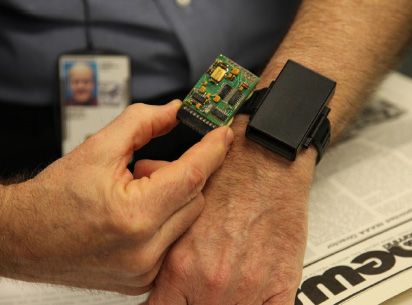NIH in History
Patient Activity Monitors Brought Greater Objectivity to Psychiatry
Until the 1970s, human “calculators”—nurses and research assistants—measured the behavioral manifestations of psychiatric illnesses and disorders by recording their observations of patients in laboratory or clinical settings. But the data were subjective and it was nearly impossible to compare results from different research centers.

Photo: Hank Grasso, NIH Office of History
NIH developed patient activity monitors that provided nonsubjective measurements of movement. A circuit board, containing amplifiers, counters, memory, and a clock, was slid into a protective casing that could be worn like a wristwatch.
Then in 1975 members of NIMH’s Research Services Branch—engineers Theodore Colburn and Bruce Smith with the help of electronics technicians Jerry Guarini and Norwood Simmons—built a novel instrument that provided the world’s first continuous, nonsubjective measurements of human activity levels. Lightweight and portable, this patient activity monitor (PAM) consisted of a quartz timer, motion sensor, and microprocessor and could be attached to a wrist, hung from a belt, or placed in a pouch at the small of the back. It calculated bodily movements in 15-minute intervals for up to 10 days. Researchers retrieved data by opening the monitor and downloading the information.
Measuring hyperactivity: Judith Rapoport, the current chief of NIMH’s Child Psychiatry Branch, used PAMs in the late 1970s and early 1980s to study hyperactive children. The PAMs confirmed that these children are not only inappropriately active (too active doing school work and not active enough on the basketball court), but, compared with nonhyperactive children, more active throughout the day and, surprisingly, slightly more active while sleeping. The PAMs also pinpointed the times at which hyperactive children are most active—during the early morning and early to mid-afternoon hours—and affirmed the benefits of drug treatment.
Rapoport and her colleagues found that the drug dextroamphetamine sulfate, a stimulant used to treat hyperactivity, does not calm hyperactive children as once thought. Rather, it increases task-appropriate activity; patients on the drug functioned better in the classroom as well as on the basketball court. PAMs helped refute a theory that suggested that hyperactive children respond differently to stimulants than do nonhyperactive children. On stimulants, both groups exhibited less motor activity when performing school-like tasks.
Bipolar disorder: PAMs could also measure the activities of patients with bipolar disorder. Thomas Wehr, onetime chief of NIMH’s Clinical Psychobiology Branch, used PAMs to chart the phases, remissions, and relapses of bipolar patients who were admitted to the psychiatric ward at NIH’s Clinical Center. Bipolar disorder is characterized by episodes of mania (abnormally increased energy or mood) alternating with episodes of depression. The researchers detected a fivefold increase in activity—even during sleep—in mania versus depression. Wehr detected a curious pattern: People with rapidly cycling bipolar disorder (four or more episodes of depression or mania a year) experience at least one night of sleeplessness before transitioning from depression to mania. This pattern is masked, however, when patients are on drug treatments that tone down mania. Wehr also found that if rapidly cycling bipolar patients in a depressed phase stay awake for 40 hours they usually transition into mania or hypomania for days or weeks. The research suggested that the biological clocks in bipolar patients are out of sync.
Neurological disorders: NIMH’s Research Services Branch manufactured four generations of PAMs, hundreds in all, that were also used in studies on Parkinson disease and tardive dyskinesia (characterized by repetitive, involuntary, purposeless movements). PAMs were so promising that requests from other institutions began pouring in.
PAMs have improved over time and have become less cumbersome, more reliable, and more powerful, and they can even detect light. Today they are used to assess sleep duration and disturbances, seasonal affective disorder, and treatments for chronic fatigue syndrome.
Brian Casey is a Stetten Fellow in the NIH Office of History. Special thanks go to Judith Rapoport, Thomas Wehr, and Newlin Morgan (NIMH biomedical engineer) for their help with this article. Morgan donated a PAM to the NIH DeWitt Stetten, Jr., Museum of Medical Research. The museum welcomes all inquiries about possible donations of scientific and medical artifacts of historical significance. To donate an item, e-mail museum@nih.gov or call 301-496-6610.
This page was last updated on Monday, May 2, 2022
